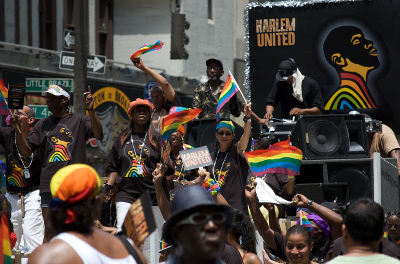
Photo taken at New York City Pride by Tadekk, 2008. License: CC BY 2.0. https://www.flickr.com/photos/tadekk/4184079836/in/album-72157622972335626
As LGBTQ people have been invisibilized, criminalized, and outcast, they have created ways to respond specific to their geographies. Like the injustices they have suffered, their tactics of resilience and resistance and their spaces and places are similar to but unique from other marginalized groups. Since sexuality is not always visible in a person’s appearance, certain types of places and spaces have developed as key environments for LGBTQ people to find one another, develop relationships, and build community. Due to unjust laws and social mores, socialization among LGBTQ people focused on sex and relationships or was limited to small groups until the late nineteenth and early twentieth centuries. LGBTQ people created social and political spaces in order to share face-to-face contact and find community. The physical landscape of LGBTQ lives, therefore, plays a special role in this group’s history. This chapter looks at a range of LGBTQ spaces and places to provide a broad context for thinking about them as they are discussed in other chapters. Read more » [PDF 2.5 MB]
The views and conclusions contained in the essays are those of the authors and should not be interpreted as representing the opinions or policies of the U.S. Government. Mention of trade names or commercial products does not constitute their endorsement by the U.S. Government.
Part of a series of articles titled LGBTQ America: A Theme Study of Lesbian, Gay, Bisexual, Transgender, and Queer History.
Last updated: October 10, 2016
